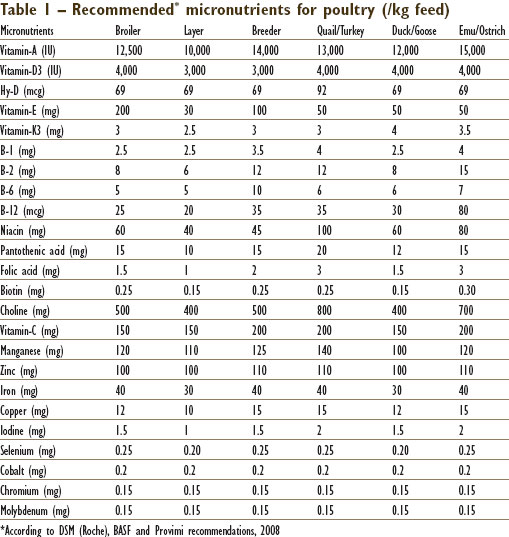Role of micronutrients in poultry production

Micronutrients are essential nutrients that birds require in small quantities to perform various vital physiological functions in the body. Even though dietary requirements are minor, they play a major role in the body metabolism, enzyme system, various physiological functions, reproduction and growth. However, most of these micronutrients cannot be synthesised by the bird itself.
The micronutrient requirements of different species of birds that were recommended by BIS, NRC, ARC, etc. long ago are inadequate and outdated. Moreover, these recommendations are now considered as minimum required levels to prevent deficiency and not optimal levels. The latest optimal micronutrient requirements for different species of birds, recommended by top vitamins and premix manufacturers in the world like BASF, DSM (Roche) and Provimi are shown in Table 1. The micronutrients are usually added to the feed as vitamin and mineral premixes, in addition to their levels in the natural feedstuffs. Micronutrients as part of various enzymes, co-enzymes, co-factors, etc. perform several physiological functions in the body. They are needed for optimising growth rate, reproduction, health, immunity and overall performance of the birds. The physiological functions and the deficiency symptoms of various micronutrients are summarised in Table 2.
Regular diet no longer enough
The performance of modern hybrid layers and broilers cannot reach optimum levels with mere traditional macro and micronutrients alone. They require additional micronutrients and non-nutrient performance enhancers for optimal production. Hence the nutritionists have to expand the traditional micronutrient list, based on the research works carried out throughout the world in the past two decades. For example Hy-D, Vit.-C, chromium, cobalt and molybdenum are included here because, whilst their deficiency may not produce typical deficiency symptoms, their presence at right levels will improve the performance of the birds significantly. They are needed for optimal performance by the present day hybrid birds and during stressful conditions. For example, vitamin C can be synthesised by poultry to some extent, but its dietary supplementation will not only alleviate stress, especially summer stress, but also improve immunity in the birds. Similarly, Hy-D, the metabolic form of vitamin D will improve bone and shell strength. Normally chromium, cobalt and molybdenum deficiencies may not be applicable because their requirements are very small and invariably met from regular feed and water. However, some soils and feedstuffs are deficient in these minerals and under these circumstances their supplementation will improve the performance of the birds.
Ultra trace elements
The trace minerals in feed can be further classified into regular trace minerals and ultra-trace elements. If the requirements are less than 1mg/kg diet (<1ppm, usually few ppb) they can be called ultra-trace elements. However their requirements are not established because most of them are toxic, with very little safety range. Arsenic, boron, cadmium, chromium, cobalt, fluorine, molybdenum, selenium and many more minerals may be classified under ultra-trace elements. Unspecified variations in the performance of birds in farms with the same hybrid, feed, micro environment and management might be partly due to variations in the levels of these ultra-trace elements in the water. Hence they are not usually supplemented in the feed and the natural levels in various feedstuffs and drinking water will be sufficient.
New generation micronutrients
Besides the micronutrients listed in Tables 1 and 2, a new list of herbal active principles, which have some specific functions in the body are presented in Table 3. Since many of these principles have antimicrobial activities, they can be used as an alternative to antibiotics. They can also be used for boosting the immunity in the birds and for value added egg and meat production. Hence these substances may be listed under “new generation micro-nutrients”.











